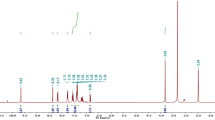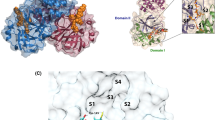Abstract
Tuberculosis is responsible for ~3 million deaths annually and is one of the most prevalent infectious diseases known to mankind. Despite ongoing developments in medicine, the emergence of drug resistant Mycobacterium tuberculosis remains of great interest, specifically in developing countries where medical treatment is not readily available. The aim of this study is to identify and explore the binding affinities of novel potential inhibitors that can irreversibly inhibit the intein protein via a covalent bond formation with its active site cysteine. Our search for new leads as potential protein splicing inhibitors is based on Michael acceptor-like structures since they are strong electrophiles which react covalently with the nucleophilic cysteine SH group in the enzyme active site. Structure-based virtual screening using a hybrid non-covalent/covalent docking was performed. Furthermore, molecular dynamic simulations (MD) and extensive post-dynamic analysis were performed in order to ensure the stability of the docked ligand-enzyme complexes and provide insight into the binding affinities and interaction patterns of the screened inhibitors. Interestingly, three novel hits have shown better binding affinity in comparison to experimentally determined compounds with known protein splicing inhibitory activity. MD simulations also revealed that the docked compounds are fairly stable in the protein active site. Per-residue interaction analysis has highlighted the most important active site residues contributing to the inhibitor binding.





Similar content being viewed by others
References
Ahmed SM, Kruger HG, Govender T, Maguire GE, Sayed Y, Ibrahim MA, Naicker P, Soliman ME (2013) Comparison of the molecular dynamics and calculated binding free energies for nine FDA-approved HIV-1 PR drugs against subtype B and C-SA HIV PR. Chem Biol Drug Des 81(2):208–218
Andrews JR, Shah NS, Gandhi N, Moll T, Friedland G, Ferry T, Collaboration C (2007) Multidrug-resistant and extensively drug-resistant tuberculosis: implications for the HIV epidemic and antiretroviral therapy rollout in South Africa. J Inf Dis 196(Suppl 3):482–490
Case DA, Cheatham TE 3rd, Darden T, Gohlke H, Luo R, Merz KM Jr, Onufriev A, Simmerling C, Wang B, Woods RJ (2005) The amber biomolecular simulation programs. J Comp Chem 26(16):1668–1688. doi:10.1002/jcc.20290
Espinal A, Espinal MD, Adalbert PH, Simonsen L, Boulahbal F (2001) Global trends in resistance to antituberculosis drugs. N Engl J Med 344:1294–1303
Forli S, Raccoon|AutoDock VS: an automated tool for preparing AutoDock virtual screenings. http://autodock.scripps.edu/resources/raccoon. Accessed 13 Aug 2013
Hudson A, Imamura T, Gutteridge W, Kanyok T, Nunn P (2003) The current anti-TB drug research and development pipeline. Article available at http://www.who.int/tdr/publications/documents/anti-tb-drug.pdf. WHO reference number: TDR/PRD/TB/031 W
Huet G, Daffé M, Saves I (2005) Identification of the Mycobacterium tuberculosis SUF machinery as the exclusive mycobacterial system of [Fe-S] cluster assembly: evidence for its implication in the pathogen’s survival. J Bacteriol 187:6137–6146
Huet G, Castaing J-P, Fournier D, Daffé M, Saves I (2006) Protein splicing of SufB is crucial for the functionality of the Mycobacterium tuberculosis SUF machinery. J Bacteriol 188:3412–3414
Intein R, Shingledecker K, Jiang S-q, Paulus H (2000) Reactivity of the cysteine residues in the protein splicing active center of the Mycobacterium tuberculosis. Arch Biochem Biophys 375:138–144
Iseman M (1993) Drug therapy-treatment of multidrug-resistant tuberculosis. N Engl J Med 329:784–791
Karpoormath R, Sayed Y, Govender P, Govender T, Kruger HG, Soliman ME, Maguire GE (2012) Pentacycloundecane derived hydroxy acid peptides: a new class of irreversible non-scissile ether bridged type isoster as potential HIV-1 wild type C-SA protease inhibitors. Bioorg Chem 40(1):19–29
Makatini MM, Petzold K, Arvidsson PI, Honarparvar B, Govender T, Maguire GE, Parboosing R, Sayed Y, Soliman ME, Kruger HG (2012) Synthesis, screening and computational investigation of pentacycloundecane-peptoids as potent CSA-HIV PR inhibitors. Eur J Med Chem 57:459–467
Naicker P, Achilonu I, Fanucchi S, Fernandes M, Ibrahim MA, Dirr HW, Soliman ME, Sayed Y (2012) Structural insights into the South African HIV-1 subtype C protease: impact of hinge region dynamics and flap flexibility in drug resistance. J Biomol Str Dyn doi. doi:10.1080/07391102.2012.736774
Ouyang X, Zhou S, Su CTT, Ge Z, Li R, Kwoh CK (2013) CovalentDock: automated covalent docking with parameterized covalent linkage energy estimation and molecular geometry constraints. J Comp Chem 34(4):326–336
Paulus H (2000) Protein splicing and related forms of protein auto-processing. Ann Rev Biochem 69:447–496
Paulus H (2007) Protein splicing inhibitors as a new class of anti-mycobacterial agents. Drugs Fut 32:973–984
Perler FB (2000) In base, the intein database. Nucl Acids Res 28:344–345. doi:10.1093/nar/28.1.344
Pettersen EF, Goddard TD, Huang CC, Couch GS, Greenblatt DM, Meng EC, Ferrin TE (2004) UCSF chimera: a visualization system for exploratory research and analysis. J Comp Chem 25(13):1605–1612
Raimundo S, Yhang M, Ho H (2006) Transmission of tuberculosis with exogenous re-infection and endogenous reactivation. Mathem Popul Stud 13:181–203
Rattan A, Kalia A, Ahmad N (1998) Multidrug-resistant Mycobacterium tuberculosis: molecular perspectives. Emerg Inf Dis 4:195–209
Santos MMM, Moreira R (2007) Michael acceptors as cysteine protease inhibitors. Mini Rev Med Chem 7(10):1040–1050
Stover CK, Warrener P, VanDevanter DR, Sherman DR, Arain TM, Langhorne MH, Anderson SW, Towell JA, Yuan Y, McMurray DN, Kreiswirth BN, Barry CE, Baker WR (2000) A small-molecule nitroimidazopyran drug candidate for the treatment of tuberculosis. Nature 405:962–966
Thomsen R, Christensen MH (2006) MolDock: a new technique for high-accuracy molecular docking. J Med Chem 49(11):3315–3321. doi:10.1021/jm051197e
Trott O, Olson AJ (2010) AutoDock Vina: improving the speed and accuracy of docking with a new scoring function, efficient optimization, and multithreading. J Comp Chem 31:455–461
Tufariello JoAnn M, John Chan, Flynn JL (2003) Mechanisms of host and bacillus that contribute to persistent infection. Lan Inf Dis 3:578–590
Zhang Y, Yew WW (2009) Mechanisms of drug resistance in Mycobacterium tuberculosis. Int J Tuber Lung Dis 13:1320–1330
Zhang LZ, Zheng Y, Callahan B, Belfort M, Liu Y (2010) Cisplatin inhibits protein splicing, suggesting inteins as therapeutic targets in mycobacteria. J Biol Chem 286:1277–1282
Zignol M, Hosseini MS, Wright A, Weezenbeek CL-v, Nunn P, Watt CJ, Williams BG, Dye C (2006) Global incidence of multidrug-resistant tuberculosis. J Inf Dis 194:479–485
Acknowledgments
Authors greatly acknowledge Mr. Ouyang Xuchang and Prof. Kwoh Chee Keong from School of Computer Engineering in Nanyang Technological University, Singapore, for their valuable discussions and technical assistance with CovalentDock software. Also the authors would like to thank the Center of High Performance Computing (www.chpc.ac.za), Cape Town, for the computational facility and the South African National Research Foundation (NRF) and School of Health Sciences, UKZN, for funding.
Author information
Authors and Affiliations
Corresponding author
Electronic supplementary material
Below is the link to the electronic supplementary material.
Rights and permissions
About this article
Cite this article
Blake, L., Soliman, M.E.S. Identification of irreversible protein splicing inhibitors as potential anti-TB drugs: insight from hybrid non-covalent/covalent docking virtual screening and molecular dynamics simulations. Med Chem Res 23, 2312–2323 (2014). https://doi.org/10.1007/s00044-013-0822-y
Received:
Accepted:
Published:
Issue Date:
DOI: https://doi.org/10.1007/s00044-013-0822-y




